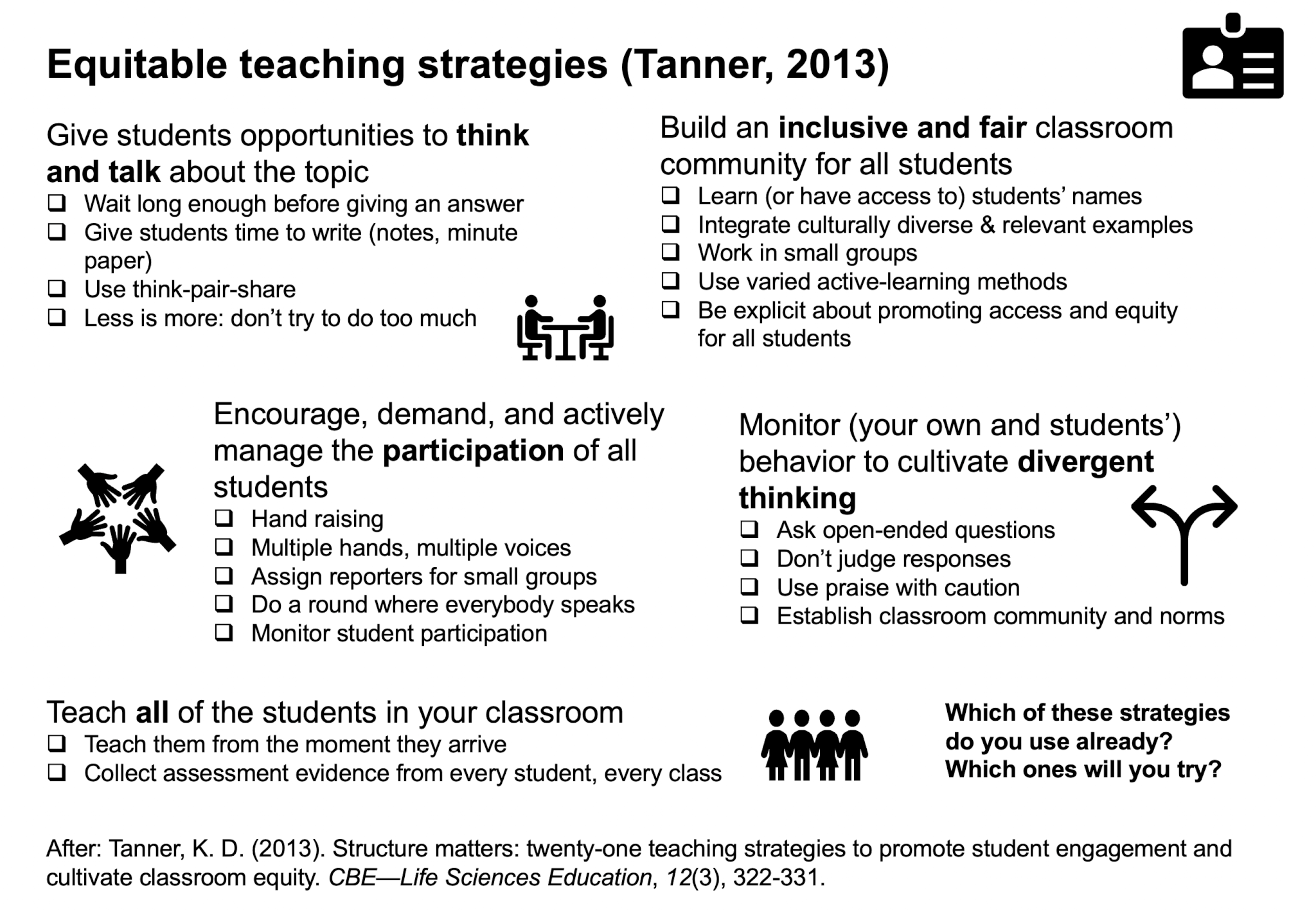
Recommended reading: “Structure Matters: Twenty-One Teaching Strategies to Promote Student Engagement and Cultivate Classroom Equity” (Tanner, 2013)
Teaching for sustainability is about so much more than teaching the content and skills described in the SDGs, or even the cross-cutting sustainability competencies. Today, I talked with teachers who asked what they could do in their courses where the curriculum does not mention anything related to sustainability, and if they should even do anything. Do all courses always need to connect to sustainability? In my opinion, everything is connected to sustainability, and even if you don’t want to explicitly address it in every course and all the time, there are so many things you can do to use your teaching on any content and skills for sustainability.
One article that I find super helpful is “Structure matters: twenty-one teaching strategies to promote student engagement and cultivate classroom equity.” (Tanner, 2013). It is not about sustainability, but it is contributing to it anyway by giving super simple teaching tricks that help teachers to pay attention that all students are invited to participate and to personally connect to the topic. In a nutshell (but go read the original article, since it not only provides a checklist but also explains why each of the strategies is important and why they work):
- give all students time to think (Wait more than 2 seconds after asking a question before you answer it yourself! Let them take notes and assign minute papers!) and opportunities to talk (think-pair-share!). Most important tip here that we probably all need to consider over and over again: Don’t try to do too many things! Rushing through content does not help anyone. If students don’t have time to think and talk, they are not going to be able to integrate all the new content we throw at them into their thinking anyway, so why do it in the first place?
- include all students in the larger class discussions (insist on people raising their hands so not only the fastest person shouting in gets heard; make sure you don’t always pick the same person; let several students respond to the same question in their own words; …)
- build an inclusive and fair classroom community for all students (learn names [or pretend to — read my favorite “name tent” article!]; use diverse examples so people can identify and get exposed to different perspectives; let them work in small groups; use different active learning methods; talk about how you want to give all students equal access to education, and how diverse perspectives and voices are important to scientific progress. And be explicit about wanting EVERYBODY to succeed!)
- monitor (your own and students’) behavior to cultivate divergent thinking rather than training them to assume that there is always only one correct answer (open-ended questions and no judging of responses or over the top praise for engagement) and establish norms (like making mistakes is a learning opportunity; we treat each other with respect)
- teach all students in your classroom. Be aware that you are establishing norms not just for your classroom but also students’ assumption of how things work in your discipline from the moment they walk in, so if you focus on explaining the exams right away, the focus of the whole course is assumed to be about the assessment in the end. If you want participation, make sure everybody gets to say something very early on. If you want to make sure you are teaching everybody, don’t just give feedback to people who are coming up to talk with you, include formative feedback for everybody through multiple-choice questions, minute papers, or other methods.
Teaching for sustainability is something that needs to be integrated not only in what we teach, but in how we teach, in which behavior we model and demand. All of the tips above are good practice in teaching anyway, but by integrating them into our teaching culture, we are also contributing a tiny little bit to teaching for sustainability, no matter what course and content we are teaching.
Tanner, K. D. (2013). Structure matters: twenty-one teaching strategies to promote student engagement and cultivate classroom equity. CBE—Life Sciences Education, 12(3), 322-331.
Liberating Structures: Methods for “Including and Unleashing Everyone” – Teaching for Sustainability says:
[…] (“1-2-4-all”) is basically a version of think-pair-(2-pairs-together)-share (one of the equitable classroom techniques that I wrote about the other day). Here are two other methods that we used in our “Teaching […]
"Liberating structures: Engaging everyone to build a good life together" (Lipmanowicz et al., 2015) - go read it and try them! - Adventures in Oceanography and Teaching says:
[…] markers of whom they came from. This is the next step (or maybe great in combination with?) the equitable classroom techniques that I wrote about the other […]
Reflections on a seminar on "Introducing Sustainability Competencies" - Adventures in Oceanography and Teaching says:
[…] FOR is so easy to do! This is, for example, where all my “Liberating Structures” and equitable teaching strategies etc come in, that we can use on any content and then just raise the point that there are methods […]
Reflections on "How do I cultivate a sense of joy, passion, and purpose in my teaching, and how do I share that with my students?" - Adventures in Oceanography and Teaching says:
[…] even when they are not teaching about it, for example through “Liberating Structures” and equitable teaching strategies. And putting a lot of effort into normalizing conversations about sustainability, while being […]
Planning a seminar on relationships in the classroom - Adventures in Oceanography and Teaching says:
[…] For general “teaching tips” for classroom equity, I will bring the Tanner (2013) article. […]